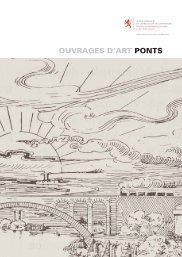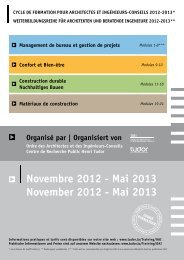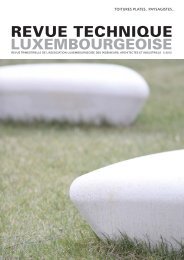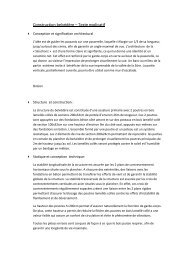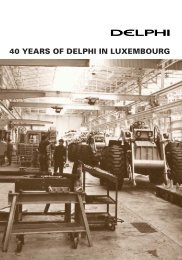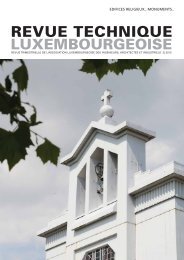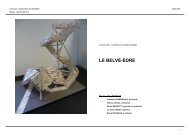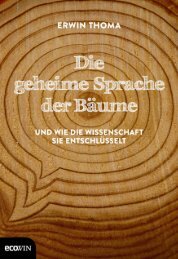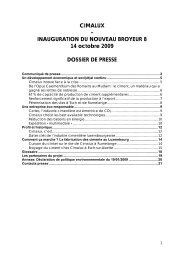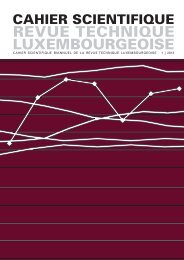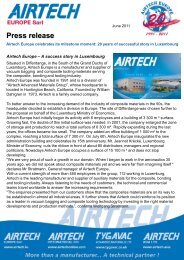Revue Technique Luxembourgeoise
Revue Technique Luxembourgeoise
Revue Technique Luxembourgeoise
Create successful ePaper yourself
Turn your PDF publications into a flip-book with our unique Google optimized e-Paper software.
DOSSIER | REVUE TECHNIQUE LUXEMBOURGEOISE 2 | 2011<br />
49<br />
produced special tooling, such as jigs and fixtures, presses,<br />
welding equipment, conveyor belts, automatic machines<br />
and robots for the GM European Assembly Plants. From<br />
1981 to 1987, GMLO also manufactured components (f.ex.<br />
fuel pumps) and expanded its business to outside customers<br />
in an attempt to provide a more balanced workload for<br />
the production departments. The production of Jigs and<br />
Fixtures ceased in 1987 and GM Luxembourg started its reconversion<br />
by selling its production and equipment.<br />
_May 1981: The inauguration of GMLO<br />
_May 1985 Inauguration of the European Technical Centre (ETC)<br />
In May 1985, the European Technical Centre was inaugurated<br />
at Luxembourg. S.A.R. Grand Duc Henri and many<br />
famous representatives from political and economical sectors<br />
participated in the inauguration.<br />
The new installations of General Motors Luxembourg were<br />
inaugurated on May 13, 1981, followed by an open house<br />
on May 16. This open house included a tour of the facilities,<br />
video shows and an exhibition of GM vehicles. About 150<br />
guests - featuring top American and Luxembourg’s business,<br />
economic, political and social representatives as well<br />
as representatives from the European plants of General Motors<br />
- attended.<br />
_1982: Start of the Technical Centre Activities in Luxembourg<br />
In 1982, the technical centre activity was created within<br />
GMLO to provide a unique source for the supply of advanced<br />
technology design. This activity was given different<br />
names, but eventually was called ESEC (European System<br />
Engineering Centre) to highlight the European activities of<br />
the site. This was in response to the needs of various divisions<br />
of the electrical components group (such as Delco<br />
Electronics, created in 1982) to have a European presence<br />
and share in the expanding market of sophisticated engine<br />
and emission control systems.<br />
_1988 - 1993 A new orientation<br />
In 1988, the General Motors Corporation formed a group<br />
called ACG (Automotive Component Group) to provide<br />
central coordination of the components supply divisions of<br />
General Motors. The ETC in Luxembourg became part of<br />
this group.<br />
The site continued its transformation into a technical centre:<br />
Following the first phase of the technical centre in 1983,<br />
the expansion project was approved in 1989. In April 1990,<br />
the company began a 2 billion FLUX expansion (particularly<br />
in thermal testing and engine testing facilities) to enable the<br />
site to become a complete and fully-focused technical centre.<br />
With wind tunnels, the EMI/RFI chamber, test cells and the<br />
tool lab expansion, the size of the facility was doubled.<br />
_Jan. 1992 – Feb. 1993 Construction of the wind tunnels<br />
Two wind tunnels were built: the Thermal Management<br />
System tunnel (TMS) to support thermal system development,<br />
and the Engine Management System tunnel (EMS).<br />
The Climatic Wind Tunnels allow development of engine<br />
and thermal management systems and emissions measurement<br />
under extreme environmental conditions. The main<br />
challenge of the construction was to integrate the wind<br />
tunnels in an existing building.



